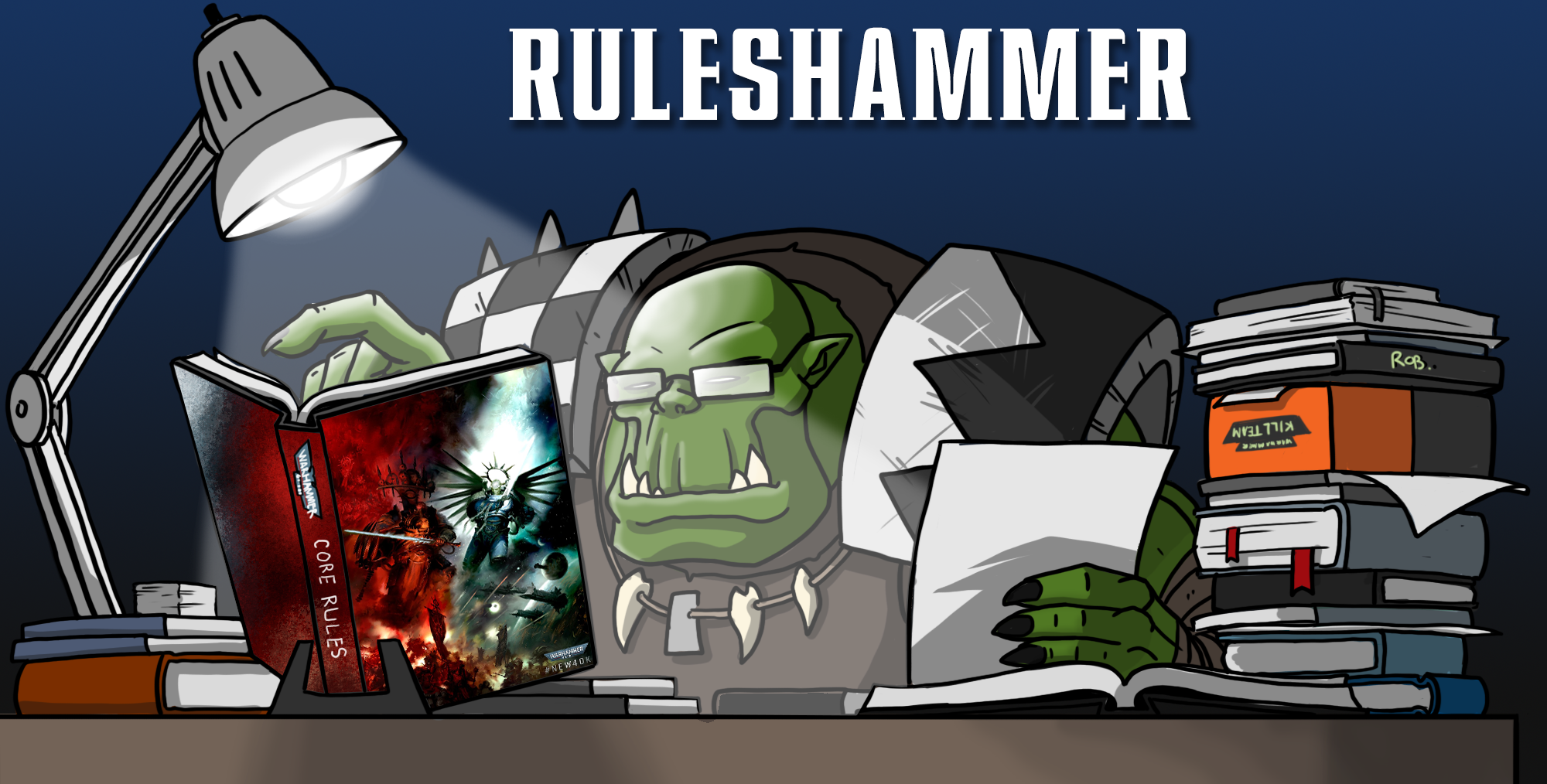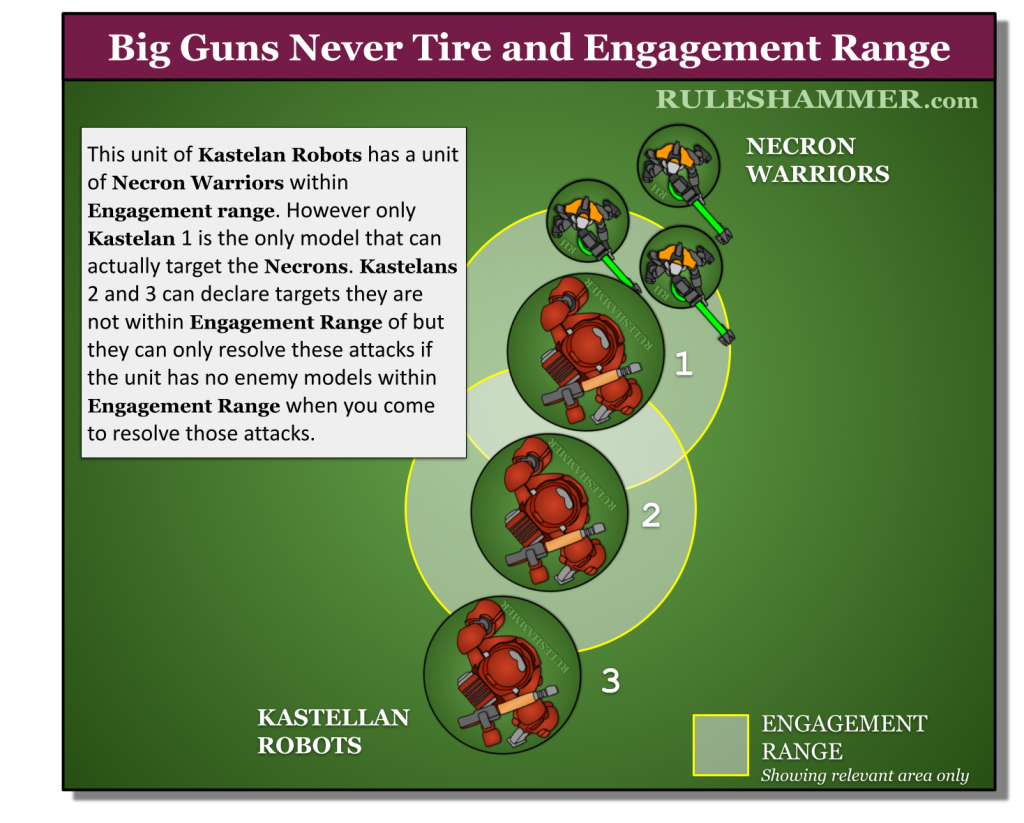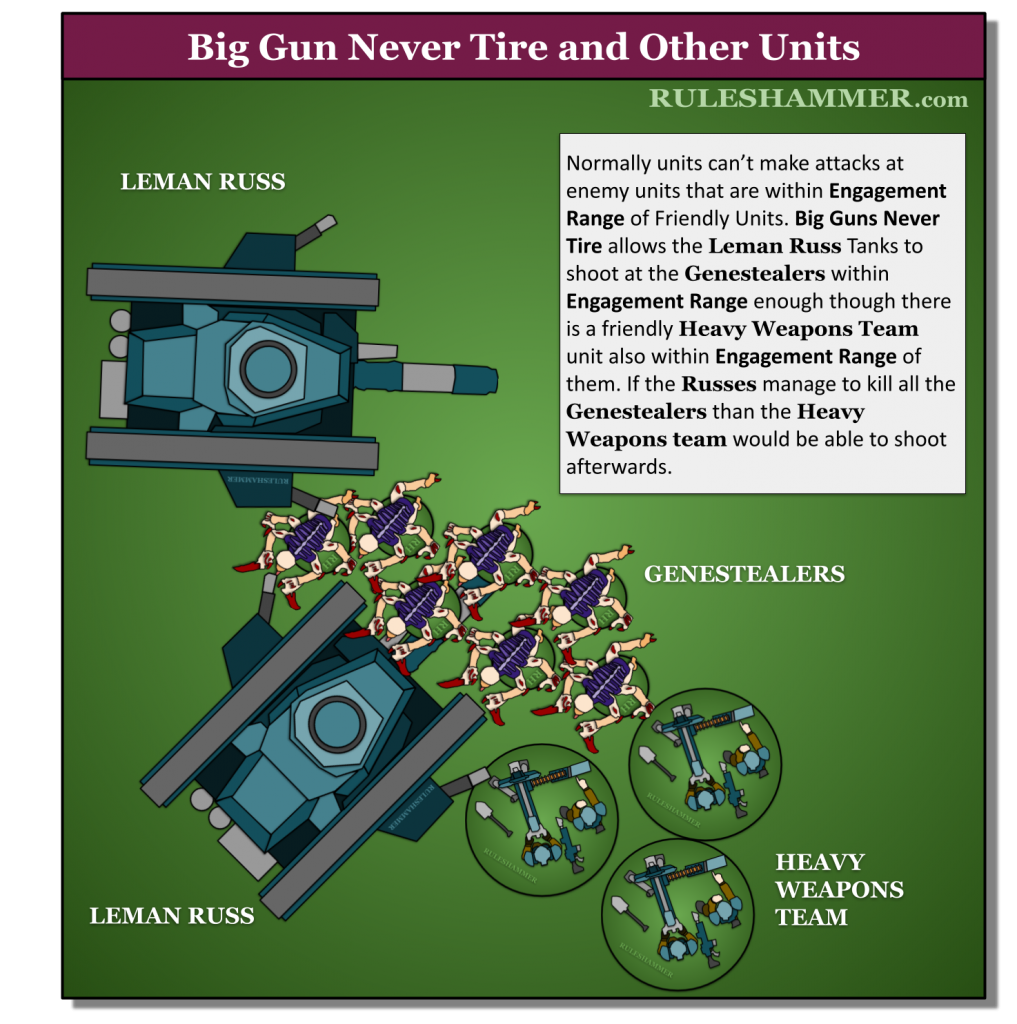Welcome to Ruleshammer! This article should help explain the ins and outs of Big Guns Never Tire, the Tau Battlesuit rule (which is very similar), and Pistols which are surprisingly different.
Table of Contents
Big Guns Never Tire and Battlesuits
I think the first thing to do is compare Big Guns Never Tire (BGNT) and the Tau Battlesuits rule:
BIG GUNS NEVER TIRE
A VEHICLE or MONSTER model can make attacks with ranged weapons even when its unit is within Engagement Range of enemy units, but it can only make such attacks against enemy units that it is within Engagement Range of. In such circumstances, VEHICLE and MONSTER models can target an enemy unit even if other friendly units are within Engagement Range of the same enemy unit.
Note that if a VEHICLE or MONSTER unit has more than one ranged weapon, you can still choose to target units that are not within Engagement Range of the firing model’s unit, but they will only be able to make the attacks with that weapon if all enemy units within Engagement Range of the firing model’s unit have been destroyed when you come to resolve those attacks. In addition, when a VEHICLE or MONSTER model shoots a Heavy weapon, subtract 1 from the hit rolls when resolving that weapon’s attacks while any enemy units are within Engagement Range of that model’s unit.
and now the Tau rule.
BATTLESUITS
BATTLESUIT models in this unit can make attacks with ranged weapons even when their unit is within Engagement Range of enemy units, but they can only make such attacks against enemy units that they are within Engagement Range of. In such circumstances, those models can target an enemy unit even if other friendly units are within Engagement Range of the same enemy unit.
Note that if a BATTLESUIT model has more than one ranged weapon, you can still choose to target units that are not within Engagement Range of its unit, but it will only be able to make the attacks with that weapon if all enemy units within Engagement Range of its unit have been destroyed when you come to resolve those attacks. In addition, when a BATTLESUIT model shoots a Heavy weapon, subtract 1 from the hit rolls when resolving that weapon’s attacks while any enemy units are within Engagement Range of that model’s unit.
The first thing worth mentioning about both of these rules is how focused on models they are (as opposed to units). Big Guns Never Tire is written almost as if units of multiple VEHICLE or MONSTER models don’t exist to some extent. Battlesuits is more specific to models in a Battlesuit unit so that it’s clear that the Drones in a unit can’t make use of the rule. Other than that though they are fundamentally the same rule. They both have the reminder that you can still target outside of Engagement Range (more on that later), and both have -1 to hit roll penalties for Heavy Weapons. While the Battlesuit rule has brought shooting in Engagement range to the forefront for units of models, it’s actually not a new thing – in 9th lots of factions have had units of VEHICLEs or MONSTERs that can do this using the Big Guns Never Tire rule. Here are a few examples:
- Killa Kans
- Paragon Warsuits
- Deff Koptas
- Snazzwagons
- Kastellan Robots
- Ironstrider Ballistarius
- Canoptek Spyders
I have a unit in Engagement Range. Which models can shoot?
Both rules actually have the same limitation on which models can shoot and it’s just the models which are actually within Engagement Range
but it can only make such attacks against enemy units that it is within Engagement Range of.
This used to be far harsher than it is now; in the previous codex for Admech there was no exception to the “can’t move” effect of one of their protocols for Pile In or Consolidation; this could cause them to end up as above rather easily.
As for “who can shoot” though it’s the same for Battlesuits, with at least a nod that they might have more than one model in their unit:
but they can only make such attacks against enemy units that it is within Engagement Range of.
Battlesuits have even more to be worried about however due to how their drones can cause the unit to end up within Engagement Range but not any Battlesuit models themselves.
It’s helpful to remember that Pile in and Consolidate moves must be made towards the closest enemy model on a per-model basis, so if you have any nearer units to the Battlesuits they might be able to move towards them to get within engagement range, allowing them to fight and shoot those units instead. The situation in the diagram is also rather extreme but not impossible, especially with Tau players stringing drones out for objective control or aura range increases.
Can the Tau player separate the drones away from the Battlesuits with the Stratagem?
No.
Use this Stratagem in your Command phase. Select one T’AU EMPIRE unit from your army that is not within Engagement Range of any enemy units and contains both DRONE models and models without the DRONE keyword. Split that unit into two units, one containing all of the DRONE models, and the other containing all of the models without the DRONE keyword.
The stratagem can’t be used on units that are within Engagement Range of enemy units.
Which units can I shoot at?
Normally units can’t shoot at enemy units that are within Engagement Range of Friendly units, however BGNT specifically allows for this:
can target an enemy unit even if other friendly units are within Engagement Range of the same enemy unit.
What about Look Out, Sir or units with the Bodyguard rule?
Look Out, Sir still works even within Engagement Range so there will be times when a model can’t target a character because it’s closer to another enemy unit.
Body Guard abilities still work while within Engagement Range, which is worth bearing in mind.
How are Pistols Different?
Pistols have different wording to both BGNT and Battlesuits, and arguably work the way a significant number of players think those other two rules work.
PISTOL
A model can make attacks with a Pistol even when its unit is within Engagement Range of enemy units, but it must target an enemy unit that is within Engagement Range of its own unit when it does so. In such circumstances, the model can target an enemy unit even if other friendly units are within Engagement Range of the same enemy unit.
The key thing here is that while Pistols allow a model to shoot even if it’s unit is within Engagement range of an enemy unit similarly to BGNT and Battlesuit, what’s different is that these models when using a pistol must target an enemy unit that is within Engagement range of its own unit, not one for which the model itself is in Engagement Range.
Another bit of Pistols that is often overlooked though is that their unit can actually do the same thing as a Vehicle/Monster or Battlesuit unit. That is, you can still target attacks outside hoping to be able to resolve them by the time you get to them. The Locked in Combat rule only prevents making attacks, not targeting (except against units within Engagement Range of friendly units).
LOCKED IN COMBAT
Models cannot make attacks with ranged weapons while their unit is within Engagement Range of any enemy models. Models also cannot target enemy units within Engagement Range of any other units from your army – the risk of hitting your own troops is too great.
So if you have 10 models in your unit locked in combat, 5 of them can use Pistols to try and kill the models within Engagement range, and the other 5 could target a different unit not within Engagement range. However the latter five would only be resolved if all the models within Engagement Range of your unit are killed first.
Other Notes Worth Mentioning
Blast
Weapons with Blast specifically can’t be used while within Engagement Range. Despite Big Guns Never Tire being the main way this might be allowed, the restriction is actually part of the Blast rule itself.
Blast weapons can never be used to make attacks against a unit that is within Engagement Range of the firing model’s unit, even if the weapon has the Pistol type or if the firing model is a VEHICLE or a MONSTER – firing high-explosives at point-blank range is simply unwise.
Destroying Enemy Units?
One unspoken element of both BGNT and the Battlesuits rule is the exact wording about when out of Engagement Range attacks are allowed to be resolved. They both say this:
…but they will only be able to make the attacks with that weapon if all enemy units within Engagement Range of the firing model’s unit have been destroyed when you come to resolve those attacks.
not enemy models, enemy units. I really don’t for a minute suggest this is played as written though. As far as I’m aware the consensus is that if your opponent removes models such as to have none within Engagement range when you get to those attacks, then you make them. Even if the unit still has models remaining and has not been destroyed. There’s a multitude of reasons that an opponent might do this, such as:
- Prioritising keeping the unit within Engagement range of another of your units.
- Wanting to shoot with that unit next turn but not have an ability to avoid the Falling Back restriction.
- Wanting to charge with that unit again next turn.
- Wanting to do an action with that unit next turn.
- Not wanting to fight against your unit again in this turns Fight Phase.
Of course all of these have to be weighed against how like they think the unit is to survive the turn, which can come down to when in your turn this shooting happens, and the type of unit they are fighting. A Tau player for instance might always remove the engaged models first to free their unit up to shoot. A Tyranids player might be less inclined.
Pre-FAQ Suggestion (if we every get one for this it’s been years): Enemy units do not need to be destroyed to resolve the attacks targeted at none Engagement Range Targets, just the enemy models that were within Engagement Range when the unit was selected to shoot.
Have any questions or feedback? Got a rules question you want answered? Drop us a note in the comments below, ask a question in our Ruleshammer form, or head over to r/ruleshammer to discuss.







